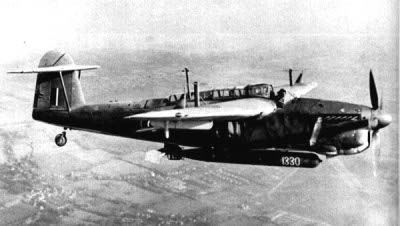![]() The Pacific War Online Encyclopedia
The Pacific War Online Encyclopedia
|
| Table of Contents |

Torpedo bombers, as the name implies, were naval aircraft designed to deliver torpedoes against shipping. They could also be employed as horizontal bombers against ground targets. Some were even employed at times as dive bombers.
The torpedo bomber was originally envisioned as a kind of flying torpedo boat, capable of slipping past defenses to threaten even the largest warships. The concept was an old one, with the first practice drop of a torpedo by an aircraft taking place in 1914 in Britain, and the first torpedoing of a ship in combat taking place the next year. However, a torpedo capable of damaging a battleship weights nearly a ton, which was a rather heavy load for a single-engine aircraft at the start of the Second World War. This meant that a loaded torpedo bomber was quite sluggish. Furthermore, the necessity of delivering aerial torpedoes from low altitude and close range at a modest aircraft speed meant that even the high-performance torpedo bombers introduced later in the war were vulnerable during their approach. Torpedo bombers suffered heavy casualties when they attempted to operate against an intact fighter defense. The case of the American torpedo bombers at Midway is legendary, but it should be remembered that the Japanese torpedo squadrons also suffered heavy losses, at Midway and elsewhere.
The odds of survival for torpedo bomber crews could be improved by supplying an adequate fighter escort, to drive off or at least preoccupy the enemy's fighters; by developing robust torpedo designs that could be dropped at higher speed and from greater altitude; by developing torpedo bombers with the performance to take advantage of higher drop speeds and the sturdiness to survive combat damage by antiaircraft fire; and by sending in the torpedo bombers shortly after attacks by dive bombers and fighters that distracted the enemy and suppressed his antiaircraft defenses. A cursory examination of the Midway battle shows that the American torpedo squadrons had none of these things going for them. By contrast, the American torpedo squadrons had all these things working for them during the naval battles of 1944, when they suffered much lower losses and enjoyed much greater success. However, torpedo bombing against capital ships remained a highly dangerous mission throughout the war. Only the fact that the targets were extremely valuable justified the losses typically experienced by these aircraft.
Japanese torpedo squadrons benefited from the superiority of the Zero fighter early in the war, employed an excellent aerial torpedo, and were adept at coordinating their attacks. However, like most Japanese aircraft, Japanese torpedo bombers were fragile and vulnerable to antiaircraft fire. Deadly at first, the Japanese torpedo squadrons became increasingly ineffective as the average skill of Japanese pilots diminished and American fighters and antiaircraft steadily improved.
Maneuvering warships were difficult targets even for
experienced crews under ideal conditions. During the attack on Force Z, where the Japanese medium bombers acting as
torpedo bombers faced no fighter opposition and only anemic
antiaircraft fire, the highly trained
crews were still unable to achieve more than a 12% to 16% hit
rate. This only became worse as Allied defenses improved.
Torpedoes are of no use against anything but shipping, and it was unacceptable for a large percentage of the strike aircraft on a carrier to be useless for raids against ground targets. All torpedo bombers were also capable of operating as horizontal bombers, and because they were designed to carry a heavy torpedo, they could also carry a heavy bomb load. The Americans made the serendipitous discovery that the TBF Avenger was even capable of operating as a dive bomber if its sturdy landing gear were lowered to act as a dive brake. Horizontal bombing, even against a stationary target, was notoriously inaccurate: Japanese B5N Kate crews training for horizontal bombing for the Pearl Harbor attack achieved an initial hit rate of just 10%, which improved to 33% with extensive practice.
Not all torpedo bombers were single-engine carrier aircraft. The Japanese made extensive use of their medium naval bombers as torpedo bombers, but found that these large aircraft were terribly vulnerable during their approach. The Australians had more luck with the Beaufort, which had enough performance to be highly effective against Japanese shipping.
References
The Pacific War Online Encyclopedia © 2007, 2009, 2012-2013 by Kent G. Budge. Index